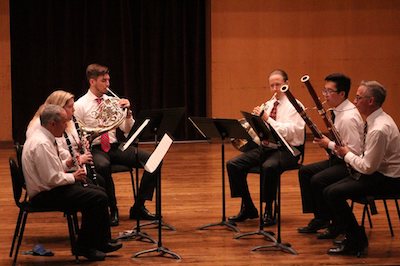by David Kulma

Mozart’s five Divertimenti, K. Anh. 229 are originally for a trio of basset horns — rare yet sonorous alto clarinets — so these works have been arranged for various other trios over the years. In this case, the Third in B-flat major was played with refined shadings and clear, flowing precision by an ensemble of TCO assistant principals: oboist Jeffrey Rathbun, clarinetist Daniel McKelway, and bassoonist Barrick Stees. Following the usual five-movement structure with two minuets, this fluffy music has a surprise: the finale’s coda clearly references the vigorous opening Allegro. The straightforwardly classical Adagio was imbued with a lovely, generous feeling, the two Menuetti flowed pleasantly along, and the main body of the Rondo finale was charmingly light-hearted.
Rathbun, McKelway, and Stees were joined by pianist Jerry Wong (faculty at Kent State) and guest hornist Hans Clebsch (Cleveland Orchestra) for a delightful rendition of Mozart’s Quintet for Piano and Winds in E-flat, K. 452. Opening with a richly grand calmness, the first movement mixed regal lines in the woodwinds with the silly, if effective, second theme’s half-step rocking. The broad Larghetto featured lovely flourishes for each player, while the Rondo showed off the group’s adroit cheerfulness. Wong’s sparkling filigree combined well with Clebsch’s regal playing and the vibrant tones of the woodwinds.
After intermission, McKelway, Stees, and Clebsch returned with three Kent Blossom students — clarinetist Meghan Colbert, bassoonist Ryan Yamashiro, and hornist Nathan Peebles — to play the original sextet version of Mozart’s Serenade in E-flat, K. 375. Most often performed in its later version with added oboes, this sextet lacks the textural brilliance of the octet, but contains all the necessary material for this pleasing music to come across.
The outer four movements balance around a gorgeous central Adagio. The opening Allegro maestoso was grand and sturdy, while the final Allegro was drivingly joyful. Of the two stately dance movements, the first Menuetto was pushed forward in tempo, to gripping effect, while the second included tastefully paced slow-downs. The Adagio, one of most Mozart’s beauties, was on the fast side. This tempo worked wonderfully for the players to spin the repeated-note accompaniments into buoyant soundscapes, but wiped free every cadence — especially the last — of its charm. The three Kent Blossom students held their own with the seasoned professionals in Mozart’s always-demanding music.
Published on ClevelandClassical.com August 7, 2018.
Click here for a printable copy of this article



